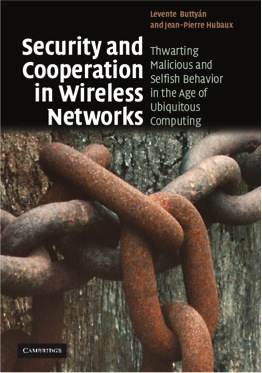Course Objectives
This graduate-level course is to understand the main challenges related to malicious and selfish behaviors in wireless networks. The course considers almost all security and privacy issues of major kinds of wireless networks, including Cellular, WiFi, Vehicular, Mesh, Ad hoc, Sensor Networks, and RFID communications. It is primarily designed and suitable for PhD students from electrical and computer engineering (Communications and Networking) and computer science. It could also be open to Master's students.
Intended Learning Outcome
Students should be able to: describe and classify security goals and attacks in wireless networks; describe security architectures of the following wireless systems and networks: 802.11, GSM/UMTS, RFID, ad hoc/sensor networks; reason about security protocols for wireless network; implement mechanisms to secure 802.11 networks.
Slides
- Introduction to Course: Introduction to Security and Privacy in Wireless Network, Upcoming Wireless Networks, Course Organization/Contents, Textbooks.
- Security and Cooperation in Wireless Networks (Textbook Review) I: Thwarting malice: security mechanisms: Naming and addressing, Establishment of security associations, Secure neighbor discovery, Secure routing in multi-hop wireless networks, Privacy protection, Secure positioning.
- Security and Cooperation in Wireless Networks (Textbook Review) II: Thwarting selfishness: behavior enforcement: Brief introduction to game theory, Enforcing fair bandwidth sharing at the MAC layer, Enforcing packet forwarding, Wireless operators in a shared spectrum, Secure protocols for behavior enforcement.
- Introduction to Cryptography I: Encryption and Adversary Model, Symmetric Key Encryption, Block Cipher, Block Cipher Model of Operation
- Introduction to Cryptography II: Asymmetric-key Encryption, Message Authentication Codes and Hash Function, Digital Signature, Session Key Establishment Protocols, Pseudo-Random Generator, Advanced Authentication Techniques
- The Security of Existing Wireless Networks: Cellular networks, WiFi LANs, Bluetooth.
- Upcoming Wireless networks: Personal communications: Wireless mesh networks, Hybrid ad hoc networks, Mobile ad hoc networks, Vehicular networks, Sensor networks, RFID, Mobility in the Internet.
- Trust Assumptions and Adversary Models: Trust, Scurity, and Privacy
- Naming and Addressing: The future of naming and addressing in the Internet, Attacks against naming and addressing, Protection techniques.
- Establishment of Security Associations: Key establishment in sensor networks, Exploiting physical contact, Exploiting mobility, Exploiting the properties of vicinity and of the radio link, Revocation.
- Securing Neighbor Discovery: Statistical Wormhole Detection, Multi-dimensional Scaling, Wormhole detection based on distance estimation, Wormhole detection using position information of anchors, Wormhole detection with directional antennas
- Privacy Protection: Important privacy related notions and metrics, Privacy in RFID systems, Location privacy in vehicular networks, Privacy preserving routing in ad hoc networks.
- Secure routing in multi-hop wireless networks: Routing protocols for mobile ad hoc networks, Attacks on ad hoc network routing protocols, Securing ad hoc network routing protocols, Provable security for ad hoc network routing, Secure routing in sensor networks.
- A Brief Tutorial on Game Theory for Wireless Networks I: Introduction to Game Theory, Static games.
- A Brief Tutorial on Game Theory for Wireless Networks II: Dynamic games and Repeated games
- Selfish behavior at the MAC layer of CSMA/CA: Operating principles of IEEE 802.11, Detecting selfish behavior in hotspots, Selfish behavior in pure ad hoc networks.
- Selfishness in Packet Forwarding: Packet Forwarding in Ad Hoc Networks
- Wireless operators in shared spectrum: Multi-domain sensor networks, Border games in cellular networks
Books
Security and Cooperation in Wireless Networks "Thwarting Malicious and Selfish Behavior in the Age of Ubiquitous Computing", by Levente Buttyan and Jean-Pierre Hubaux
 This textbook addresses the fundamental questions related to this problem, in particular:
How are users and devices identified? How can a security association be established between two wireless peers? How can packets be securely and cooperatively
routed in a multi-hop network? How can the fair share of bandwidth between nodes located in the same radio domain be guaranteed? How are wireless operators
likely to behave, if they have to share a given part of the spectrum? How can naturally selfish players be encouraged to behave cooperatively? And, above all,
how is privacy protected? The book treats each of these questions from a theoretical point of view and illustrates them by means of concrete examples such as
mesh, ad hoc, vehicular, sensor, and RFID networks. In order to be properly understood, this book requires some familiarity with networking, but a
special effort has been made to keep the material as simple as possible. An introduction to the necessary concepts of security and game theory is provided.
This textbook addresses the fundamental questions related to this problem, in particular:
How are users and devices identified? How can a security association be established between two wireless peers? How can packets be securely and cooperatively
routed in a multi-hop network? How can the fair share of bandwidth between nodes located in the same radio domain be guaranteed? How are wireless operators
likely to behave, if they have to share a given part of the spectrum? How can naturally selfish players be encouraged to behave cooperatively? And, above all,
how is privacy protected? The book treats each of these questions from a theoretical point of view and illustrates them by means of concrete examples such as
mesh, ad hoc, vehicular, sensor, and RFID networks. In order to be properly understood, this book requires some familiarity with networking, but a
special effort has been made to keep the material as simple as possible. An introduction to the necessary concepts of security and game theory is provided.
